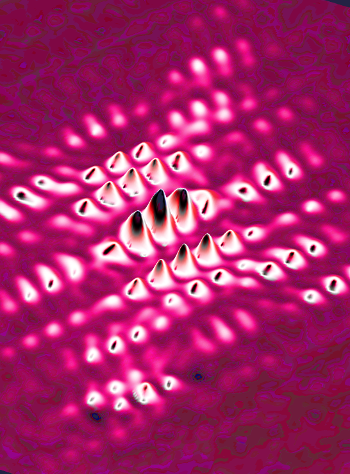UNSW takes quantum step
 Australian tech researchers have made two silicon atom qubits “talk” to each other.
Australian tech researchers have made two silicon atom qubits “talk” to each other.
The breakthrough represents another step on the road to the quantum computing revolution.
A research team led by UNSW Professor Michelle Simmons, Director of the Centre of Excellence for Quantum Computation and Communication Technology (CQC2T), is the only group in the world that has the ability to see the exact position of silicon qubits in solid state.
Prof Simmons’ team create the atom qubits by precisely positioning and encapsulating individual phosphorus atoms within a silicon chip. Information is stored on the quantum spin of a single phosphorus electron.
The team’s latest advance – the first observation of controllable interactions between two of these qubits – is published in the journal Nature Communications.
It follows two other recent breakthroughs using this unique approach to building a quantum computer.
By optimising their nano-manufacturing process, Simmons’ team has also recently created quantum circuitry with the lowest recorded electrical noise of any semiconductor device.
Additionally, they have created an electron spin qubit with the longest lifetime ever reported in a nano-electric device – 30 seconds.
“The combined results from these three research papers confirm the extremely promising prospects for building multi-qubit systems using our atom qubits,” Prof Simmons says.
Professor Simmons, who was named 2018 Australian of the Year in January for her pioneering quantum computing research, says her team’s ground-breaking work is inspired by the late physicist Richard Feynman.
“Feynman said: ‘What I cannot create, I do not understand’. We are enacting that strategy systematically, from the ground up, atom by atom,” she said.
“In placing our phosphorus atoms in the silicon to make a qubit, we have demonstrated that we can use a scanning probe to directly measure the atom’s wave function, which tells us its exact physical location in the chip. We are the only group in the world who can actually see where our qubits are.
“Our competitive advantage is that we can put our high-quality qubit where we want it in the chip, see what we’ve made, and then measure how it behaves. We can add another qubit nearby and see how the two wave functions interact. And then we can start to generate replicas of the devices we have created,” she said.
For the new study, the team placed two qubits – one made of two phosphorus atoms and one made of a single phosphorus atom – 16 nanometres apart in a silicon chip.
“Using electrodes that were patterned onto the chip with similar precision techniques, we were able to control the interactions between these two neighbouring qubits, so the quantum spins of their electrons became correlated,” says study lead co-author, Dr Matthew Broome, formerly of UNSW and now at the University of Copenhagen.
“It was fascinating to watch. When the spin of one electron is pointing up, the other points down, and vice versa.
“This is a major milestone for the technology. These type of spin correlations are the precursor to the entangled states that are necessary for a quantum computer to function and carry out complex calculations,” he says.
Study lead co-author, UNSW’s Sam Gorman, says: “Theory had predicted the two qubits would need to be placed 20 nanometres apart to see this correlation effect. But we found it occurs at only 16 nanometres apart.
“In our quantum world, this is a very big difference,” he says. “It is also brilliant, as an experimentalist, to be challenging the theory.”







 Print
Print